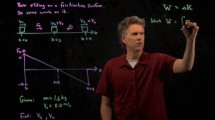Abstract
We will describe a one-quarter pilot algebra-based introductory physics course for pre-health and life science majors. The course features videos with biomedical experts and cogent biomedically inspired physics content. The materials were used in a flipped classroom as well as an all-online environment where students interacted with multimedia materials online and prior to engaging in classroom activities. Pre-lecture questions on both the medical content covered in the video media and the physics concepts in the written material were designed to engage students and probe their understanding of physics. The course featured group discussion and peer-lead instruction. Following in-class instruction, students engaged with homework assignments which explore the connections of physics and the medical field in a quantitative manner. Course surveys showed a positive response by the vast majority of students. Students largely indicated that the course helped them to make a connection between physics and the biomedical field. The biomedical focus and different course format were seen as an improvement to previous traditional physics instruction.




Similar content being viewed by others
References
AAAS (2011) Vision and change in undergraduate biology education. American Association for the Advancement of Science, Washington, DC
AAMC (2001) Report IV—contemporary issues in medicine: basic science and clinical research. American Association of Medical Colleges, Washington, DC
AAMC-HHMI Committee (2009) Scientific foundations for future physicians. Association of American Medical Colleges, Washington, DC
Adams WK, Perkins KK, Podolefsky NS, Dubson M, Finkelstein ND, Wieman CE (2006) New instrument for measuring student beliefs about physics and learning physics: the Colorado Learning Attitudes about Science Survey. Phys Rev Spec Top Phys Educ Res 2(1):010101
Bogdanich W, Rebelo K (2011) Bad X-rays found again at a Brooklyn hospital. The New York Times
Christensen W, Johnson JK, Van Ness GR, Mylott E, Dunlap JC, Anderson EA, Widenhorn R (2013) Developing and assessing curriculm on the physics of medical instruments. CBE Life Sci Educ 12(2):250–261
Crouch CH, Hilborn R, Kane SA, McKay T, Reeves M (2010) Physics for future physicians and life scientists: a moment of opportunity. APS News 19(3):8. http://www.aps.org/publications/apsnews/201003/backpage.cfm
Gladding G, Selen M, Stelzer T (2015) smartPhysics. MacMillan Education. https://www.smartphysics.com/Account/LogOn?ReturnUrl=%2f
Gouvea J, Sawtelle V, Geller BD, Turpen C (2013) A framework for analyzing interdisciplinary tasks: implications for student learning and curricular design. CBE-Life Sci Educ 12(2):187–205
Hilborn RC, Friedlander MJ (2013) Biology and physics competencies for pre-health and other life science students. CBE Life Sci Educ 12(2):170–174
Institute of Medicine (2001) Crossing the quality chasm: a new health system for the 21st century. National Academy Press, Washington, DC
Kortemeyer G (2007) The challenge of teaching introductory physics to pre-medical students. Phys Teach 45(9):552–557
Kutschera E, Dunlap JC, Byrd M, Norlin C, Widenhorn, R (2013) Pulse oximetry in the physics lab: a colorful alternative to traditional optics curriculum. Phys Teach 51:495–497
Lawley TJ, Saxton JF, Johns MM (2005) Medical education: time for reform. Trans Am Clin Climatol Assoc 116:311
Meredith DC, Redish EF (2013) Reinventing physics for life-science majors. Phys Today 66(7):38
Moore RW, Foy RL (1997) The scientific attitude inventory: a revision (SAI II). J Res Sci Teach 34(4):327–336
Mylott E, Dunlap JC, Klepetka R, Widenhorn R (2011) An easily assembled laboratory exercise in computed tomography. Eur J Phys 1227–1235
Mylott E, Kutschera E, Widenhorn R (2014) Bioelectrical impedance analysis as a laboratory activity: at the interface of physics and the body. Am J Phys 82(5):521–528
NRC (2003) BIO2010: Transforming undergraduate education for future research biologists. National Research Council (US), Committee on Undergraduate Biology Education to Prepare Research Scientists for the 21st Century. National Academies Press, US
Openstax College (2015) Openstax College. https://openstaxcollege.org/textbooks/college-physics
Redish EF, Hammer D (2009) Reinventing college physics for biologists: explicating an epistemological curriculum. Am J Phys 77(7):629–642
Redish EF, Steinberg RN (1998) Student expectations in introductory physics. Am J Phys 66(3):212–224
Ruskell T, Selen M, Stelzer T (2015) FlipItPhysics. https://www.flipitphysics.com/Account/LogOn?ReturnUrl=%2f
Singer SR, Nielsen NR, Schweingruber HA (eds) (2012) Discipline-based education research: understanding and improving learning in undergraduate science and engineering. National Academies Press, Washington, DC
Van Ness GR, Widenhorn R (2012) Engaging the community through an undergraduate biomedical physics course. Am J Phys 80:1094–1098
Walker J (2015) Retrieved from Physics with MasteringPhysics, 4/E. http://www.pearsonhighered.com/educator/product/Physics-with-MasteringPhysics-4E/9780321541635.page
Ward ML (2010) Cancer risks debated for type of X-ray scan. The New York Times
Woodin T, Vasaly H, McBride D, White G (2013) Integration of physics and biology: synergistic undergraduate education for the 21st century. CBE-Life Sci Educ 12(2):120–123
Acknowledgments
The authors would like to thank all student volunteers, physicians, and biomedical experts who participated or helped with the course creation: Charles R Thomas, Wolfram Laub, James Dolan, Nathan Bronson, Matthew Bentz, Stefanie Kaech Petrie, Jane Weissman, Kate Haas, Samuel Matz, Grace Van Ness (all Oregon Health and Science University) and Stanley B. Teplick from Teplick Custom Vision. This work was supported by Grants (DUE-1141078 and DUE-1431447) from the National Science Foundation.
Author information
Authors and Affiliations
Corresponding author
Ethics declarations
Compliance with Ethical Standards
All procedures performed in studies involving human participants were in accordance with the ethical standards of the institutional and/or national research committee and with the 1964 Helsinki Declaration and its later amendments or comparable ethical standards.
Rights and permissions
About this article
Cite this article
Mylott, E., Kutschera, E., Dunlap, J.C. et al. Using Biomedically Relevant Multimedia Content in an Introductory Physics Course for Life Science and Pre-health Students. J Sci Educ Technol 25, 222–231 (2016). https://doi.org/10.1007/s10956-015-9588-y
Published:
Issue Date:
DOI: https://doi.org/10.1007/s10956-015-9588-y



